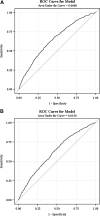Hospital readmission in general medicine patients: a prediction model
- PMID: 20013068
- PMCID: PMC2839332
- DOI: 10.1007/s11606-009-1196-1
Hospital readmission in general medicine patients: a prediction model
Abstract
Background: Previous studies of hospital readmission have focused on specific conditions or populations and generated complex prediction models.
Objective: To identify predictors of early hospital readmission in a diverse patient population and derive and validate a simple model for identifying patients at high readmission risk.
Design: Prospective observational cohort study.
Patients: Participants encompassed 10,946 patients discharged home from general medicine services at six academic medical centers and were randomly divided into derivation (n = 7,287) and validation (n = 3,659) cohorts.
Measurements: We identified readmissions from administrative data and 30-day post-discharge telephone follow-up. Patient-level factors were grouped into four categories: sociodemographic factors, social support, health condition, and healthcare utilization. We performed logistic regression analysis to identify significant predictors of unplanned readmission within 30 days of discharge and developed a scoring system for estimating readmission risk.
Results: Approximately 17.5% of patients were readmitted in each cohort. Among patients in the derivation cohort, seven factors emerged as significant predictors of early readmission: insurance status, marital status, having a regular physician, Charlson comorbidity index, SF12 physical component score, >or=1 admission(s) within the last year, and current length of stay >2 days. A cumulative risk score of >or=25 points identified 5% of patients with a readmission risk of approximately 30% in each cohort. Model discrimination was fair with a c-statistic of 0.65 and 0.61 for the derivation and validation cohorts, respectively.
Conclusions: Select patient characteristics easily available shortly after admission can be used to identify a subset of patients at elevated risk of early readmission. This information may guide the efficient use of interventions to prevent readmission.
Trial registration: ClinicalTrials.gov NCT00204048.
Figures
References
-
- McDonald KM, Sundaram V, Bravata DM, et al. Closing the quality gap: a critical analysis of quality improvement strategies. Volume 7: Care Coordination. AHRQ Publication No. 04(07)-0051-7. Rockville, MD: Agency for Healthcare Research and Quality; 2007. Available at www.ahrq.gov/downloads/pub/evidence/pdf/caregap/caregap.pdf. Accessed November 9, 2009. - PubMed
-
- Frankl SE, Breeling JL, Goldman L. Preventability of emergent hospital readmission. Am J Med. 1991;90:667–674. - PubMed



